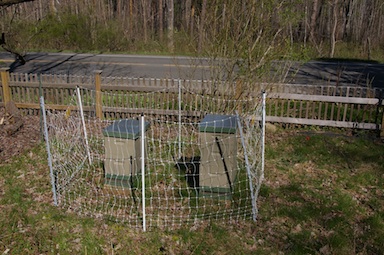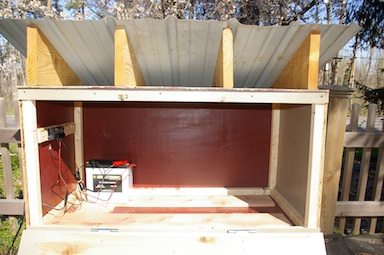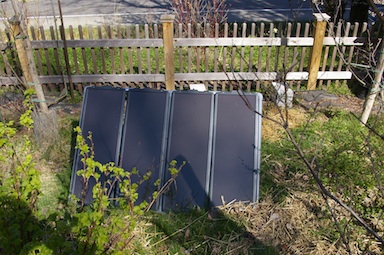April 7, 2012
Keeping bears away from bees, and more
Last summer, I heard of a bear sighting at Turkey Hill and Mount Pleasant Roads, and immediately knew the bears were moving in. Those bears apparently moved on through the City of Ithaca, but my beehives were in danger. I ordered some additional electric fencing and a bear-worthy charger. I tore down an old fence for chickens and put up a new garden fence to keep the kids away from the electric fence.
And then, I didn't do much. Last summer's heat crushed me, as did travel, work, and the basic challenges of construction projects around beehives. My parents surprised me for my birthday with 60 watts of solar panels, which was wonderful. Of course, it suddenly inspired ideas of larger infrastructure to take advantage of that power to fuel some of my further-out ideas.
Eight or nine months later, I finally have the solar cells charging a battery, which powers a fence charger, which keeps the fence on.

Yard with fences, beehives, solar panels, control box

The electric fence around the beehives.
The fence is a movable fence. It increases the risk that bears will get through, but also makes it possible for me to mow around the hives. All of this should also keep skunks away.
The power source for the fence is in a box a short distance away, with the energizer itself mounted on the outside of the box. The energizer can work on either 110V AC, which would have meant my originally planned long extension cord, or 12V DC, which the solar panels and batteries provide. I thought the fence charger would only run at night, but its "night setting" runs it faster at night and slower during the day. Eventually I'll add something like this Lumatrol photocell so some projects can run only at night while others run all the time.

Battery, charge controller, and room for a lot more.
It's a deep-cycle battery, though the fence energizer consumes enough power (and the solar panels generate enough) that I probably should have bought a bigger battery. Instead, I think I'll buy another battery at some point, as I add more projects here. I certainly provided enough space - the box is 2' x 2' x 4'.
I need to finish waterproofing the box. Cedar boards and drain holes keep the equipment above water that may come in and let it dry. I also plan to put doors on the top gaps under the metal roof to have easy storage for things like garden and beekeeping tools.
What's next? Probably a flag with a downward pointing LED light, one that works more reliably than the underpowered and rusting piece of solar-powered junk I bought a few years ago. In more complicated possibilities, a set of radar guns and a weather camera pointed at the road are also on the "would like to do this year" list, though given the time it took to get this far, that may be 2013 or 2014.
Want to see a bit more? I've posted a small gallery of pictures.
Posted by simon at April 7, 2012 11:15 AM in gardening , my houseNote on photos

I'm not sure what being a democrat has to do with living in Dryden, but I raise pasture fed chickens and lambs in Dryden. All are protected by electrc netting. The chargers I use are powered by 12v batteries with solar panels. My panels are not nearly as big as yours. I am quite satisfied with the way these chargers (Intelishock B from Premier 1 supplies)
I use several hundred feet of fencing and it works quite well to protect my stock from coyotes, racoons weasels and any other threats that are not airborne.
I also protect my bee hives with the same set up.
We have had no bear issues since using the fences.
Tom QUinn
We were wondering why we hadn't seen our bear yet this year--just heard of someone hitting a bear last week at the corner of Ringwood and 13 that might have been ours. Did anyone else hear that story?
hi there. i use similar sheep netting and a 30 mile solar fencer on my hives. i think my roll of netting is a 100 feet. i also used the little 2 wire push in rods and made another outer fence with 2 electic wires as an outer boundars about a foot out from the netting. anyway, i would suggest that the netting be at least 3 feet away from the hives. when i was doing all of my research, that's what everyone suggested. i'd just hate for you to lose your hives. i lost 2 small nucs that were not inside my fence last year to a bear but he didn't get my big hives! have a great summer!